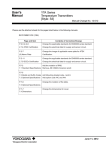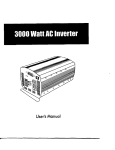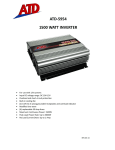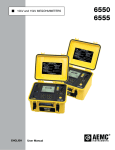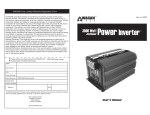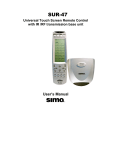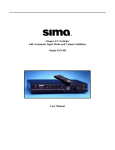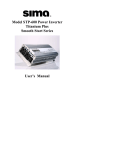Download Sima STP-3000 Owner`s manual
Transcript
STP-3000 12V DC POWER INVERTER OWNER'S MANUAL Sima Products Corporation 140 Pennsylvania Ave. Bldg. #5 Oakmont, PA 15239 800-345-7462 www.simacorp.com Page 1 of 14 STP-3000 Owner’s Manual Table of Contents 1. Introduction ................................................................................................................................. 3 2. Working Principle of your Sima STP-3000 .................................................................................. 3 2.1 Principle of Operation ..................................................................................................................... 3 2.2 SIMA ............................................................................................................................................... 3 STP-3000 Output Waveform .................................................................................................................. 3 3. Physical Layout of the Sima STP-3000....................................................................................... 4 4. Permanent Installation ................................................................................................................ 5 4.1 Where to Install ............................................................................................................................... 5 4.2 Battery ............................................................................................................................................ 5 5. Cable Hook-up ............................................................................................................................ 6 5.1 Battery Cables ( if cable installation kit is not included).................................................................... 7 6. Operation .................................................................................................................................... 8 6.1 Front Panel Controls and Indicators ................................................................................................ 8 6.2 Operating Limits ............................................................................................................................. 9 7. Accessories................................................................................................................................. 9 7.1 AC Receptacle option ...................................................................................................................... 9 7.2 Remote ON/OFF switch option ......................................................................................................... 9 7.3 DC Box-Lug connectors .................................................................................................................. 9 7.4 Manual or Automatic Transfer Switch .............................................................................................. 9 7.4 Maintenance ................................................................................................................................... 9 8. Troubleshooting .......................................................................................................................... 9 8.1 Common Problems.......................................................................................................................... 9 8.2 Troubleshooting Guide .................................................................................................................. 10 Appendix A - Battery Sizing .......................................................................................................... 10 Appendix B – Connection to Multiple Batteries ..............................................................................11 10. Limited Warranty ..................................................................................................................... 12 11. Specifications .......................................................................................................................... 12 11.1 Electrical Performance ................................................................................................................. 12 11.2 Product Dimensions .................................................................................................................... 12 STP and Sima logos and combinations thereof trademarks of Sima Products Corp., Ltd. or its subsidiaries in all countries. All other products and names mentioned herein may be property, trademarks or registered trademarks of their respective companies & owners. Entire contents copyright of Sima products Corporation Inverter Owner’s Manual © 2005Sima Products Corporation All rights reserved. Reproduction in whole or in part without permission is prohibited. Page 2 of 14 SIMA STP-3000 12V DC Owner's Manual 1. Introduction Your new Sima STP-3000 inverter is the most advanced DC to AC inverter available today from the SIMA family. It is designed to give you years of dependable services everywhere in your RV, boat, service vehicle, office, shop or remote home. Proper installation of the Sima STP-3000 is needed to obtain its best performance as instructed in this installation and operation manual. Please read carefully before installing and using your Sima STP-3000. Statements marked 'CAUTION' and 'WARNING' in this manual call for special attention about the Sima STP-3000. “CAUTION” statements identify conditions or practices that could result in damage to your Sima STP-3000 or to other equipment. “WARNING” statements identify conditions or practices that could result in personal injury or loss of life. 2. Working Principle of your Sima STP-3000 A Power Inverter electronically converts electricity of low voltage DC to 115V AC. Advanced power conversion technology has been incorporated in the design of Sima STP-3000, leading to a smaller, lighter, and easier-to-use inverter. 2.1 Principle of Operation The Sima STP-3000 first raises low voltage DC to 145 volts DC using modern high frequency power conversion techniques, and then converts the high voltage DC into 115 volts, 60Hz AC using advanced power MOSFET transistors in full bridge configuration. High surge capability to operate tough reactive loads like fluorescent lamp ballasts and inductive motors are incorporated. 170 V DC INVERTER SECTION + DC INPUT DC-DC CONVERTER POWER MOSFET CHASSIS GND GND NEUT LINE AC OUTPUT Figure 1. SIMA STP-3000 – Principle of operation 2.2 SIMA STP-3000 Output Waveform GND LIN The Sima STP-3000 generates "Quasi-Sine Wave" or "Modified Sine Wave" waveform for its AC outputs (Figure 2). It is designed to have characteristics similar to the sine wave shape of utility power. This waveform is suitable for most AC loads found in electronic equipment, transformers, and motors. It is also superior to the square waves produced by other DC to AC inverters. CAUTION: Do NOT Use Sima STP-3000 with the following RECHARGEABLE APPLIANCES Some rechargers for small nickel cadmium batteries can be damaged if connected to the STP-3000 including the following equipment types: 1). Small battery operated appliances such as flashlights, razors, and night-lights that plug directly into an ac receptacle to recharge. 2). Some battery pack chargers for hand power tools with warning labels stating that dangerous voltages are present at the battery terminals. Figure 2. Waveform of Modified Sine Wave The vast majority of battery-operated equipment uses separate chargers or transformers that are plugged into AC receptacle to produces low voltage outputs and hence would not have this problem. SIMA’s STP-3000 will power safely with less than 30-volt dc-output adapters or chargers. The Sima STP-3000 is designed to have a True RMS (root mean square) voltage of 115 volts, the same as AC power. Most digital and analog AC voltmeters are calibrated to the MEAN of the waveform rather than the true RMS value and such meters will not read the true RMS voltage of a modified sine wave correctly. True RMS reading voltmeters (such as Fluke 87, Fluke 189, Fluke 8060A, Beckman 4410, or Tektronix TDS 220) must be used to accurately measure the output voltage of your Sima STP-3000. Page 3 of 14 3. Physical Layout of the Sima STP-3000 Power flows logically from the rear terminals of the Sima STP-3000 unit forward to the front panel of the AC output receptacle (or optional junction box). All indicators, controls, and output connections are conveniently accessed from the front panel (See Figure 3a and Figure 3b). Their detail functions are explained in Section 6.1 below. A circulating fan draws cooling-air in from the rear and forces the flow out through vents on the front panel. NOTE: It is extremely important to provide adequate airspace around the unit surfaces to allow for convection cooling as described in Section 5.1 – Where To Install. Figure 3. AC and DC panels of the SIMA STP-3000 A. AC PANEL OVERLOAD INDICATOR: Lights when inverter shuts down because of severe overload. Turn inverter off. Remove cause of overload, and turn inverter on to reset . BAR GRAPH METERS: Display battery voltage and current. Current should be in the GREEN zone ONLY for continuous operation; The inverter will operate for several minutes when the current in the Yellow zone: operation with battery voltage or current in the red zone of the meter will result in protective shutdown of the inverter. ON/OFF SWITCH: Leave in OFF position during installation CAUTION! THIS IS NOT A DISCONNECT SWITCH. REMOVE POWER AT THE SOURCE BEFORE SERVICING. OVER TEMP INDICATOR: Inverter is shut down while indicator is ON. Inverter will restart automatically. Indicator lamp and alarm will turn off when the inverter cools. Lights and alarm alerts when inverter protects itself against OVERHEATING. Modular jack for Remote control AC GFI outlet (Inverter output) B. DC PANEL RED: Positive “+” CAUTION: Reverse polarity will open internal fuses and MAY damage the inverter permanently BLACK: Negative “-” CHASSIS GROUND LUG. Ventilation Opening DO NOT OBSTRUCT – Allow at least 4 inch (100 mm) clearance for air flow. WARNING: Operation of the inverter without a proper ground connection may result in an electrical safety hazard Page 4 of 14 4. Permanent Installation 4.1 Where to Install The following environmental requirements are essential for installing the inverter: a) b) c) d) e) Dry - Do not allow water to drip or splash on the Sima STP-3000. Cool – Ambient air temperature should be between 0°C and 40°C (32°F and 105°F). The cooler, the better. Ventilated – Ensure that the unit is in a compartment that is ventilated. Allow at least 2 inch (5cm) of clearance around the Sima STP-3000 for airflow. Make sure that ventilated openings on the front and rear of the unit are not obstructed. Safe – Do not install the SIMA STP-3000 in the same compartment as batteries or any place likely to accumulate flammable liquids such as gasoline (See warning below). Close to Battery – Install as close to the battery as possible so as to minimize the length of connecting cable between the inverter and the battery. Do not install in the same compartment. It is more efficient to allow longer AC wires than DC cables due to smaller current flows in the AC wires. CAUTION! To reduce fire hazard, do NOT cover or obstruct ventilation openings. To avoid overheating, DO NOT install the Sima STP-3000 in a zero-clearance compartment. WARNING! This equipment contains components that tend to produce arcs or sparks. To reduce risk of fire or explosion, do NOT install in compartments containing batteries or flammable materials or in places where equipment needs to be ignition-protected. The STP-3000 may be mounted horizontally or vertically on flat surfaces using the mounting flanges on the panels. Mounting hardware should be corrosion resistant and of #10 or larger in diameter. 4.2 Battery Battery performance strongly affects outputs from your Sima STP-3000 and correct battery size and type must be utilized. Selection criteria of batteries are listed below for your specific applications. A. Battery type The lead-acid battery of your automobile can deliver large current for a short duration, consuming a small portion of its capacity to start up the engine. It is not suited for repeated charge-discharge cycles as such services quickly wear out the battery life. Deep-cycle lead-acid batteries are marketed for repeatedly discharge and recharge cycles as used in recreational vehicles, boats, and electric golf carts. They are referred to as RV, marine, or golf-cart batteries. It is recommended that deep-cycle batteries be separated from starting batteries by battery isolators when using the Sima STP-3000. Battery isolators are solid-state electronic circuits available at marine/RV dealers and most auto-parts stores. They allow appliances be operated from auxiliary sources without discharging the vehicle's battery and automatically direct the charge from the alternator to the battery when the vehicle operates (See Figure 5 on page 11). B. Tips on Batteries 1 2 3 4 5 6 Lead-acid batteries emit hydrogen and oxygen gases, and sulfuric acid fumes when recharging. Vent the battery compartment to prevent accumulation of these gases, and do not install electronic or electrical equipment in the battery compartment. Do not smoke or carry an open flame when working around batteries. The capacity of lead-acid batteries is temperature sensitive. Battery capacity is rated at 25°C (77° F). At –20° C (0°F) the ampere-hour capacity will be about half the rated capacity. Discharged batteries will undergo a “SULFATION" process, becoming permanently damaged. Recharge immediately within a day or two. Batteries shall self-discharge in 3 to 6 months. Recharge periodically even if not in use. Check the electrolyte fluid level once a month for batteries requiring maintenance and replenish with distilled water. Overcharging results in excessive fluid loss. Permanent connectors with reliable and low resistance connection must be made to the battery posts. Do not use "alligator" clips. Connections must be regularly cleaned to prevent corrosion. Check the battery states with a hydrometer or a voltmeter. Measure the (12-volt) battery a few hours after charging or discharging. For deep-cycle batteries at 25°C (77°F), the following table may be used: Battery Voltage 12.7 ~ 12.9 12.5 ~ 12.6 12.3 ~ 12.4 12.1 ~ 12.2 11.9 ~ 12.0 Table 4. State-of-Charge 100% 80% 60% 40% 20% Your Sima STP-3000 may be connected directly to the vehicle starting battery only if it drives small loads (less than 250/300 watts) for short discharging duration (less than one hour) Immediate battery recharge is recommended. C. Alternators and Charging Systems Battery health can only be maintained with good charging systems. Recharge your deep cycle batteries when they are 50% discharged so as to ensure long battery life. Heavy-duty high-output alternators are available from RV/marine dealers and auto-parts suppliers. They produce 100 to 140 amperes of current at high voltages to charge multiple battery systems. Page 5 of 14 5. Cable Hook-up CAUTION! Loose connectors result in excessive voltage drop and may cause overheated wires and melted insulation. CAUTION! Reverse polarity connection (positive to negative) will blow the fuses in the Sima STP-3000 and may permanently damage the inverter. Damage caused by reverse polarity connection is not covered by your warranty. WARNING! Spark may be observed when connection is first made as current starts to charge up capacitors in the Sima STP-3000. Do not make this connection in the presence of flammable fumes. Explosion or fire may result. Cables connecting the inverter to the DC power source must be as short as possible and sufficiently large for the required current flow so as to minimize the voltage drop and to maintain high efficiency of the overall system. Sima’s STP-3000 comes with a basic wiring kit to permanently install your inverter to a single battery. Multiple battery installation like the examples that follow in our manual require additional cables and connectors that are not supplied and have to be purchased before installation. The supplied cables come with pre-installed ring terminals for connection from the STP-3000 to your battery. The cable kit includes the following items. 1. 1pc RED (+ POS) wire (80mm^2) 1.0 meter in length 2. 1pc RED (+ POS) wire (80mm^2) 0.5 meter in length 3. 1pc BLACK (- NEG) wire (80mm^2) 1.5 meters in length 4. 1pc GREEN (- ground) wire. 5. Fuse block assembly 6. 2 pieces 250 Amp fuses NOTE: Installation requires an open workspace free from obstructions or obstacles. Wear proper eye protection. If you are not qualified to install high power devices or if you are unsure of the proper safety precautions needed to install a high power device like the STP-3000 then STOP RIGHT HERE! CONTACT A LOCAL INSTALLATION EXPERT TO INSTALL YOUR INVERTER. Mounting the inverter and fuse block assembly: 1. 2. Make sure the inverter is turned off. Select an inverter location that is free from water and combustible fumes. You will need to purchase the necessary hardware bolts/nuts, screws…etc for your particular installation. Select fuse block location. Location must be less than 0.5 meters from battery and less than 1.0 meters from the inverter. Assemble fuse block assembly with supplied bolts/nuts. Make sure you install and secure the fuse. Mount fuse block with supplied sheet metal screws to your chosen location. Connecting the wires – refer to Fig. 4 at right: 3. 4. 5. 6. 7. 8. Connect one end of the supplied GREEN wire to the Earth Ground connection on the DC side of the inverter. Connect the other end of the GREEN wire to a secure location on vehicle chassis. Connect one end of the BLACK wire to the – NEG connection on your battery. Most MARINE type batteries have a STUD type mount in addition to a CLAMP type mount that can be used with the ring terminal. If your battery only has the CLAMP type connections you will need to purchase an adapter from your local auto parts or battery supply store to use the supplied cables. Secure with supplied lock washer and nut that came with your battery or adapter. Connect the other end of the BLACK wire to the – NEG connection on the inverter. Secure with supplied lock washer and nut. Connect one end of the shorter 0.5 meter RED wire to the end of the supplied fuse block that is closest to your battery. Secure with Fig. 4 supplied lock washer and nut Connect the other end of the shorter 0.5 meter RED wire to the + POS connection on your battery. Most MARINE type batteries have a STUD type mount in addition to a CLAMP type mount that can be used with the ring terminal. If your battery only has the CLAMP type connections you will need to purchase an adapter from your local auto parts or battery supply store to use the supplied cables Secure with supplied lock washer and nut that came with your battery or adapter. NOTE: Steps 9 & 10 are your final connections to supply power to your inverter. Making this connection will create a spark. Make sure the last connection is to the supplied fuse block. Make sure the inverter is turned off before you continue. Make sure you are wearing adequate eye protection. 9. Connect one end of the longer 1.0 meter RED wire to the + POS connection on the inverter. Secure with supplied lock washer and nut. 10. This connection will create a spark: Connect the other end of the longer 1.0 meter RED wire to the end of the supplied fuse block that is closest to the inverter. Secure with supplied lock washer and nut. Safe operation of the Sima STP-3000 requires a solid, low resistance connection to the DC power source. Page 6 of 14 5.1 Battery Cables ( if cable installation kit is not included) Safe operation of the Sima STP-3000 requires proper wires. Low resistance wiring from the battery to the Sima STP-3000 is essential to deliver high input currents at low supply voltages. Do not undermine the maximum efficiencies from your inverter and batteries with undersized copper wires. It is recommended using 2 x # l AWG or 1 x 3/0 AWG copper cable (90°C insulation rating) as the minimum size for battery connections to the Sima STP-3000. Minimize cable length to less than 10ft (3 meters) in order to maintain overall efficiency. Lower efficiency results in shorter battery run-times. Inverters may shut down below 10-volts if excessive voltage drops across the battery cables. See Table 5 for cable length and sizing. Table 5: Recommended DC Cables Sizes for Permanent Installation, for voltage drop less than 0.5Vdc total. Based on 90°C Cable. Length of each Cable Up to … 10ft. (3m) 15ft. (4.6m) 20ft. (6.1m) SIMA STP-3000 Minimum Cable Size if Minimum Cable Size if Using Single Cables Using Double Cables No. 3/0 AWG 2 x No.1 AWG 250 MCM 2 x No. 2/0 AWG 400 MCM 2 x No. 3/0 AWG Use cables rated at 90°C. For cables rated below 90°C or run in conduit, refer to your local and national electrical codes. CAUTION! Based on Table 310-17 of the U.S. National Electrical Code (NFPA 70), 1993, and on Table 1 of the Canadian Electrical Code, Part 1. Connect the supply cables to the DC terminals on the Sima STP-3000 via 5/16-inch ring terminals fixed to the cable with insulation stripped off over a length of 1/2 inch (1.25cm) from the ends. Crimp the ring terminals properly. Equivalent cable box-lug terminals (available at electrical parts suppliers) may also be used with the bare cable end inserted into the lug terminal. Secure the other cable ends to the battery terminal posts with lugs or connectors to ensure low resistance connection. Proper safe operation of the Sima STP-3000 requires solid, low resistance connection to the DC power source. Do NOT Tin the Cable Ends with Solder. Doing So Will Result in Poor Long-Term Connection! CAUTION! The Sima STP-3000 must be connected only to batteries with a nominal output voltage of 12-volts. It will not operate from a 6-volt battery, and will be damaged if connected to a 24-volt battery. 5.2 AC Wiring Connections Warning: If you are unfamiliar with high voltage wiring or unsure about how to connect this inverter, it is recommended that a qualified electrician install this inverter. 1. WARNING! Manual or automatic transfer switch may alternatively be used (See Figures 11 and 12). A transfer switch is a break before make, double pole, double throw (DPDT) switch that switches both the hot and neutral wires of the AC distribution system from one power source to the other. Manual and automatic transfer switches are available from marine and RV dealers. They are commonly used to switch between a generator and AC (utility) power. Purchase an agency-approved switch that exceeds the output ratings of both the inverter and the other source. 2. Do not connect the Sima STP-3000 and another AC source (such as a generator or utility power) to the AC wiring at the same time. The Sima STP-3000 will be damaged if its output is connected to AC voltage from another source. Damage can occur even if the STP-3000 is switched off. When installing the inverter into electrical systems with other power sources, a switching means MUST be included between the STP-3000 and the other power source so that it disallows connection to both sources at the same time. This can be a plug inserted into the desired AC power source (See Figures 10 on following page.) 3. Do not connect the Sima STP-3000 to an AC branch circuit that has high-power consumption loads. The Sima STP-3000 WILL NOT operate stoves, and other electrical appliances that consume more than 2500 watts. Do not attempt your own AC wiring unless you have the knowledge and experience to do a safe job. Your RV or boat dealer, or a licensed electrician can do the job for you if you do not wish to do your own wiring. Page 7 of 14 B. Ground Wiring The Sima STP-3000 has a lug on the rear panel to connect the chassis of the inverter and its AC output ground to the AC distribution system ground. This chassis ground lug must be connected to a grounding point, such as the chassis ground of a vehicle, or the grounding system of a boat, or the earth ground via a ground rod (a metal rod pounded into the earth), or other proper service entrance ground. Use a # 8 A WG or larger copper wire (preferably with Green/Yellow insulation) to connect the chassis ground lug to the grounding point. The neutral (common) conductor of the Sima STP-3000 AC output circuit is also connected to chassis ground to conform to the National Electrical Code requirements. Set the ON/OFF switch on the Sima STP-3000 to the ON position. Check the battery voltage indicator if it indicates within 12 to 13-volts. If it does not, check your battery and connections to the Sima STP-3000 inverter. The other indicators should be off. WARNING! Do not operate the Sima STP-3000 without connecting it to ground. Electrical shock hazard may result. 6. Operation Switch ON the Sima STP-3000 from the front panel to operate the inverter. It is now ready to drive AC loads. Turn each appliance on individually for multiple operations after switching on the STP-3000 inverter so as to reduce the simultaneous starting currents from all loads. 6.1 Front Panel Controls and Indicators A. ON/OFF Switch The ON/OFF switch turns the control circuit of the Sima STP-3000 ON and OFF (See Figure 3). It does not disconnect DC power from the battery to the Sima STP-3000 inverter. The Sima STP-3000 consumes about 0.2mA of current from the battery with the switch at the OFF position. It draws less than 700mA of no-load current from the battery with the switch at the ON position. A 100 ampere-hour battery can last more than a week discharging at this low current level. Switch the inverter off if battery is not recharged within a week or so. B. Remote ON/OFF Jack The Sima STP-3000 supports remote ON/OFF switch via an optional jack which allows users to switch the inverters ON or OFF away from the installation panel (See your SIMA dealer for more details on the STP-3000 Remote ON/OFF switch). C. Battery Voltage Indicator This indicator displays the input voltage to the Sima STP-3000 inverter. It gives readings close to the battery voltage for low input currents but gives lower readings than the battery voltage due to voltage drops across cables and connections for high input currents. The Sima STP-3000 inverter may shut down when voltage goes into the red area at the top or bottom of the indicator. Normal operations should register readings in the green zone. D. Battery Current Indicator It displays the current drawn from the battery by the Sima STP-3000 only. Normal operations register current readings in the green area with transient operations occasionally in the yellow zone. If current level goes to the red area, the STP-3000 will reduce its output voltage to protect itself. E. OVERTEMP Indicator Overheating of the Sima STP-3000 results in shutting-down itself, lighting up the OVERTEMP indicator, and sounds the alarm buzzer. Over-temperature is result of operating power ratings over 2500 watt continuous output or being installed in poorly ventilated location. It will automatically restart after cooling down . F. OVERLOAD Indicator Overloading the Sima STP-3000 shuts the inverter down with the OVERLOAD indicator signaled. Reset the invert to OFF position, then clear the fault (remove/unplug the load), before switching the ON/OFF switch back to ON. Page 8 of 14 G. ALARM Indicator –Audible alarms will sound off if any of the following conditions occur: a) b) c) OVERTEMP condition Low Battery Voltage : <10.7V Low Volt. Shutdown : <10.0V 6.2 Operating Limits A. Power Output The Sima STP-3000 delivers 2500 watts or 22.7 amperes continuously and about 3000 watts or 27.3 amperes for approximately 5 minutes. The Sima STP-3000 must be cooled down for minimum 15 minutes before it resumes operation at 2500 / 3000 watts. Wattage rating is for resistive loads like heaters while current rating is for reactive loads like motors. It operates most AC loads within these ratings and will normally start single-phase induction motors rated at 1HP or less. It fails to start large inductive motors due to huge starting currents. If the battery voltage indicator drops below 11 volts when the Sima STP-3000 is attempting to start a motor, it would not start. Ensure proper battery connections and being fully charged. Larger batteries may be needed if voltage still drops below 11 volts. See battery-sizing notes in Appendix A. B. Input Voltage The STP-3000 operates with input voltage between 10 ~15-volts. Its optimum performance ranges with input voltage between 12.0- and 14.0-volts. Low battery warning will sound with the voltage indicator in the lower red zone when input voltage drops below 10.7 volts. Voltage below 10 volts shall shut down the inverter in order to protect your batteries from being over-discharged. It takes an input voltage above 11-volts to restart the STP-3000 inverter. Input voltage above 15-volts also shuts down the inverter so as to protect the unit from excessive input voltage. The voltage indicator will be in the upper red zone. Avoid input voltages exceeding 16-volts as it may damage the inverter permanently. 7. Accessories 7.1 AC Receptacle option The AC receptacle on front panel of the Sima STP-3000 inverter offers ready access to AC power for outputs limited to 1500 watts (15A) per outlet. 7.2 Remote ON/OFF switch option This option allows the Sima STP-3000 inverter be turned on and off from a remote switch positioned up to 20 feet (6.1 meters) away, with push-button and indicator light showing inverter status (See your SIMA dealer for more details on the STP-3000 Remote ON/OFF switch). 7.3 DC Box-Lug connectors Available at electrical parts suppliers, box-lug connectors may be used in place of ring terminals. 7.4 Manual or Automatic Transfer Switch To select between power sources from inverter, generator or utility power, use manual or automatic transfer switches. The double-pole, double-throw (DPDT) switch breaks the load from one power source before making connections to another (See Section 5.2). Transfer switch is available from marine and RV equipment dealers. Purchase only agency-approved switch that covers both ratings of the inverter and the other power source 7.4 Maintenance Your Sima STP-3000 requires very little maintenance. Clean the exterior periodically with a damp cloth to prevent accumulation of dust and dirt, especially for the air intake on the rear panel and exhaust slots on the front panel to remove accumulation of dust and dirt. Regular maintenance check is recommended. Tighten screws on the DC input terminals periodically. 8. Troubleshooting 8.1 Common Problems A. Buzz in Audio Systems Portable stereo systems may not adequately filter the modified sine wave, thus producing buzzing noise from their loudspeakers when powered by Sima STP-3000 inverter. Sound systems with higher quality power supplies are recommended. B. Television Interference Television reception may be interfered when operating the Sima STP-3000 inverter. Observe the following steps to alleviate the problem: 1 Secure the chassis ground lug on the rear panel of the Sima STP-3000 solidly to the ground system of your vehicle, boat and home. 2 Do not operate high power loads simultaneously while watching television. 3 Ensure the antenna feeding the television set with adequate (“snow free”) signal and that good quality cable feeding the television. 4 Keep a distance between the televisions from the Sima STP-3000 inverter. 5 Minimize the cable length between the battery and the Sima STP-3000 with twists so as to minimize the radiated interference from the cables. Page 9 of 14 8.2 Troubleshooting Guide Problem and symptoms Possible Cause Low output voltage (96 to 104 V AC) Low output voltage and current indicator in red zone. No output voltage and voltage indicator in lower red zone No output voltage, no voltage indication. Using an voltmeter. Overload. average Low input voltage. Solution reading Use true RMS reading meter. See section 2.2 of manual Reduce load. Recharge battery, check connections and cable. 1. Inverter switched off. 2. No power to inverter. 3. Internal fuse open. 4. Reverse DC polarity. 1. Turn inverter on. 2. Check wiring to inverter. Check battery fuse 3. Have qualified service technician check and replace. 4. Have qualified service technician check and replace fuse, Observe Correct Polarity. High input voltage. Make sure that STP-3000 is connected to 12V battery, check regulation of charging system. Poor DC wiring, poor battery Use proper cable and make solid connections. condition. Change battery or use new battery. Thermal shutdown. Allow the STP-3000 to cool off. Reduce load if continuous operation required. No output voltage, voltage indicator in upper red zone. Low battery alarm on all the time, voltage indicator below 11V. No output voltage, OVERTEMP indicator on, load in excess of 3000W with 250/300A input current. No output voltage, OVERTEMP indicator on, Thermal shutdown. load less than 3000W with 300A input current. OVERLOAD indicator on. 1. Very high power load. Improve ventilation, make sure ventilation openings in The STP-3000 are not obstructed, reduce ambient temperature. 1. Remove or reduce load. Appendix A - Battery Sizing For continuous usage, deep-cycle batteries are rated by reserve capacity in minutes or by ampere-hour capacity. Reserve capacity measures the duration a battery delivers its rated current – normally at 25 amperes. A battery of 60 minutes reserve capacity can deliver 25 amperes for 60 minutes before completely discharged. The measure of cranking amperes used to rate starting batteries in automotive is not suitable for deep-cycle batteries. It is better to size your batteries more conservatively for unexpected variations. More reserve capacity means your batteries will not be discharged as deeply so that battery life will not be unduly shortened. It is recommended that the consumed ampere-hour loading should be kept less than 50% of the battery's rated capacity. Ampere–hour (AH) capacity measures battery amperage being delivered for a rated duration – normally at 20 hours. A typical marine or RV battery rated for 120 ampere–hour delivers 6 amperes for 20 hours.Battery capacity varies inversely with discharge current. At 5 amperes loading, a battery of 100AH discharges for 20 hours but at 20 amperes loading, the same battery may only last for 4 hours with its capacity reduced to 80 ampere-hours. It is therefore not suitable to compare rated ampere-hour capacity directly with battery reserve capacity.Observe the following steps to determine your battery capacity requirements: STEP 1 Determine the wattage of each appliance to be driven by the Sima STP-3000. Multiply any current ratings by 115 to obtain the power consumption in watts. STEP 2 Estimate duration of tool operation between battery charge-discharge cycles or each appliance being driven by the Sima STP-3000. STEP 3 Calculate the total watt-hours of operations, total running time in hours, and average power consumption as exemplified below: Average Power Consumption = 3275 watt-hrs ÷ 1.8 hours = 1819.44 watts For Sima STP-3000 inverter, Ampere-Hour Consumed = 3275 ÷ 10 = 327.5 ampere-hours STEP 4 Locate the battery size meeting the required operating time at the calculated power consumption level from Table 3. For the example shown, operation duration of 1.8 hours at 1819.44 watts requires the smallest battery size as two 400 amp-hr batteries in parallel, offering about 10 to 12 hours of operating time. Table 3. 12-Volt Battery Sizing Chart (for reference only) Equipment Coffee Maker Cordless Steam Iron Vacuum Cleaner (380W) Washing Machine Window Type (12100Btu/h) Totals Inverter output power (watts) 50 100 200 300 400 600 800 1000 1200 1500 2000 2500 2950 Typical Load Stereo system 19” colour TV Computer system Blender Power drill Small coffee maker Small microwave Automatic Toaster Cordless Steam Iron Full size microwave Grill Microwave Oven 42L(1.5Cu.ft) Hair dryer & washing machine Window Type (12100Btu/h) Example for Step 3 of Battery Sizing Power Consumption Operating Time 1000 watts 0.3 hour 1200 watts 0.5 hour 1600 watts 0.25 hour 2000 watts 0.25 hour 2950 watts 0.5 hour 1.8 hours AMP-HRS: Reserve capacity 50 Watt Hours (Power x Operating Time) 300 600 400 500 1475 3275 watt-hours BATTERY SIZE 75 100 200 400 90 minutes 140 minutes 180 minutes 400 minutes 900 minutes 9 HOURS 4 HOURS 2 HOURS 1.3 HOURS 1 HOUR 14 HOURS 6 HOURS 3 HOURS 2.2 HOURS 1.5 HOURS 20 HOURS 10 HOURS 4.5 HOURS 3 HOURS 2 HOURS 1 HOUR 40 HOURS 20 HOURS 10 HOURS 6 HOURS 4.5 HOURS 2.5 HOURS 1.5 HOURS 1 HOUR 0.5 HOUR 0.5 HOUR 80 HOURS 40 HOURS 20 HOURS 12 HOURS 10 HOURS 6 HOURS 4 HOURS 3 HOURS 2 HOURS 2 HOURS N.R. N.R. N.R 0.3 HOUR 1 HOUR 0.2 HOUR 0.7 HOUR 0.15 HOUR 0.5 HOUR Operating time Page 10 of 14 Appendix B – Connection to Multiple Batteries Identical batteries can be connected “+"to“+"and“–"to“–" in a parallel for larger capacities while maintaining the supply voltage of a single battery (See Figure 7). Do not mix batteries from different manufacturers or different amp-hour ratings in parallel as battery life would be shortened. NOTE: If different batteries or more than two batteries are needed, set up separate battery banks and use them separately. Battery selectors are available from marine and RV dealers to select between battery banks. Switch to either bank or disconnect all (See Figure 8.) Page 11 of 14 10. Limited Warranty Sima Products Corporation (“Company”) warrants that if the accompanying product proves to be defective to the original purchaser in material or workmanship within 90 days from the original retail purchase, the Company will, at the Company’s option, either repair or replace same without charge (but no cash refund will be made). If the product is returned within three (3) years from the original date of purchase, the Company will repair or replace the unit, however, a standardized labor-only fee will be charged. The Company will not charge a fee for any parts used in the repair. The Company will notify you of any fees to be assessed prior to servicing the unit. What you must do to enforce the Warranty: You must deliver, mail or ship the product, together with the original bill of sale and this limited Warranty statement as proof of warranty coverage to: Sima Products Corporation Attn: Customer Service 140 Pennsylvania Ave., Bldg. #5, Oakmont, PA 15139 Call customer service (800-345-7462) before sending the unit in for service. Limitation of Liability and Remedies Sima Products Corporation shall have no liability for any damages due to lost profits, loss of use or anticipated benefits, or other incidental, consequential, special or punitive damages arising from the use of, or the inability to use, this product, whether arising out of contract, negligence, tort or under any warranty, even if Sima Products Corporation has been advised of the possibility of such damages. Sima Products Corporation’s liability for damages in no event shall exceed the amount paid for this product. Sima Products Corporation neither assumes nor authorizes anyone to assume for it any other liabilities. ©2005 Sima Products Corporation IMPORTANT: The Warranty will be VOID automatically once ANY one of the followings did occur: 1. If you connect the wires to wrong terminals, the polarity will be reversed and this will damage the unit immediately. Reversed polarity will instantly void your product’s warranty; 2. Connecting the inverter’s input to a battery charger will damage the inverter and the relevant warranty is treated be voided immediately; Remarks: All returns must have a Return Authorization Number (RAN) issued prior to sending back or SIMA and or her dealer(s) can not accept the shipment.*Terms & conditions are subject to change without prior notice* This is SIMA’s only warranty, and The Company makes no warranties, express or implied, including warranties of merchantability and fitness for a particular purpose.If your product requires further service and you are unable to contact your local dealer, or the dealer is unable to provide your with the expected service, you may contact SIMA at www.simacorp.com 11. Specifications 11.1 Electrical Performance Description Output Power The first 5 minutes: Continuous: Output voltage: Output waveform: Output frequency: Input voltage: Low battery alarm Low battery shutdown: Optimum efficiency: No-load current draw without fan: Switch ON Switch OFF Sima STP-3000 3000 watts 2500 watts 115 VAC RMS ± 5% Modified sine wave. 60 Hz ± 2 Hz. 10 to 15 VDC audible, 10.8 VDC 10 VDC ≒ 90% < 0.6 ADC < 0.2mADC 11.2 Product Dimensions Description Height: inch / mm Width: inch / mm Length: inch / mm Weight: Lbs / Kg Sima STP-3000 5¾” / 148.0 mm 8¼” / 208.0 mm 18½” / 470.0 mm 14.96 Lbs / 6.80 Kg Page 12 of 14 Notes Page 13 of 14 Sima STP-3000 Inverter Owner’s Manual © 2005 Sima Products Corp., Limited. All rights reserved. Sima STP-3000~12V Rev 1.0 PN21714 Page 14 of 14
















